The Expansive Framework of Instrumental TransCommunication (ITC)
Unveiling the Foundations of ITC: Understanding the Bones of Communication with the Unknown

Everything has bones—the underlying structures that provide strength and coherence to an idea. When I think about ITC, I think about its bones: the theories and principles that form its foundation. These “bones” not only support ITC but also provide a roadmap for exploring the unseen realms it seeks to connect us with. Why does ITC exist, and what does it reveal about the nature of reality? In this article, we’ll examine ITC’s skeletal framework, exploring its scientific, metaphysical, and philosophical components.
I’ve heard every argument skeptics hurl at ITC and have worked to address their concerns thoughtfully in my experiments. Yet, the body of evidence I’ve gathered through my experiences with ITC supports it as a legitimate method of communication—especially when viewed beyond the narrow context of sweeping radios (which I still love) to the broader picture of the paranormal and what might unify all things ethereal.
I’ve concluded that all paranormal experiences stem from a single source. Whether it’s psychic abilities like telepathy and ESP, hauntings, EVPs, alien encounters, or other phenomena, the one constant is us. Our perceptions shape how we understand these experiences, as we instinctively seek to assign them meaning. While a clear framework—a theory and a method—can help us define and understand these encounters, it’s equally important to appreciate the experience itself, regardless of our beliefs. This article offers several frameworks for understanding how ITC might work while addressing skepticism along the way.
Imagine standing in a dimly lit room, your ITC device crackling with static. Suddenly, a voice cuts through—clear, direct, unmistakable. It speaks your name. These moments aren’t just theoretical; they’re intimate encounters with the unknown, inspiring the curiosity that drives ITC research forward.
ITC integrates scientific inquiry with philosophical wonder and metaphysical exploration, creating a holistic approach to the unknown. While its premise—using technology to communicate with unseen entities—has often faced skepticism, exploring its theoretical underpinnings suggests it deserves more thoughtful consideration. By examining consciousness-based theories, vibrational principles, quantum mechanics, information fields, historical evidence, theological perspectives, and esoteric concepts, we can begin to construct a credible framework for understanding ITC.
Theoretical Foundations of ITC

How Consciousness Shapes ITC Communication
ITC taps into the fabric of consciousness, often considered the foundation of reality, to link physical and metaphysical realms through sound and vibration. By accessing this collective awareness, ITC instruments link the physical and metaphysical realms, allowing entities to communicate through sound, vibration, or electromagnetic waves.
The Role of Universal Consciousness in ITC Communication
Theory: Consciousness is the fundamental substrate of reality. Entities exist as non-physical, conscious energies within this universal awareness.
Process: ITC tools serve as conduits, enabling non-physical beings to manipulate oscillations, sound waves, or electromagnetic fields to communicate.
Support:
• Aligns with analytic idealism, which suggests reality emerges from consciousness.
• Resonates with quantum mechanics, where observation appears to influence physical outcomes.
This perspective frames ITC as an extension of consciousness. Entities can be understood as facets of a larger, interconnected awareness. Imagine consciousness as a boundless ocean, with each individual a unique wave moving within it. ITC devices function like lighthouses, signaling across this vast expanse, enabling other waves—entities—to interact with us.
Exploring Thomas Campbell’s Larger Consciousness System and ITC
Thomas Campbell’s1 My Big TOE (Theory of Everything) expands this framework. Campbell posits that we are individual units of awareness within a Larger Consciousness System (LCS). ITC may occur when our consciousness streams shift frequencies, enabling interaction with other data streams in the LCS. His computational model offers a logical foundation for understanding ITC as a mechanism for growth and connection.
If consciousness is the foundation of ITC, energy is its medium. Vibrations and frequencies provide the pathways through which these non-physical messages manifest in our physical reality.

Energy and Frequency: How Vibrational Resonance Enables ITC Communication
ITC relies on energy and vibration as the foundation for communication between physical and non-physical realms. Vibrational resonance provides the pathways through which entities connect with our world, transforming subtle energy patterns into perceivable signals via ITC devices.
• Vibrational Resonance as a Gateway: Similar to ancient practices in Tibetan Buddhism and Hinduism that emphasize sound and vibration to connect with higher states of awareness, ITC employs specific frequencies to amplify communication.
• Scientific Correlations: Studies on brainwave frequencies, such as alpha and theta waves, reveal connections between altered states of consciousness and enhanced perception. These findings align with ITC experiments, where modulating specific frequencies often enhances communication clarity.
By integrating the principles of energy and vibration, ITC bridges the physical and metaphysical, echoing both spiritual traditions and modern scientific insights.
While energy and frequency theories explore the vibrations that might serve as the ‘language’ of ITC, quantum mechanics takes us deeper into the building blocks of reality itself. Could the same principles that govern particle entanglement also underpin ITC communication?
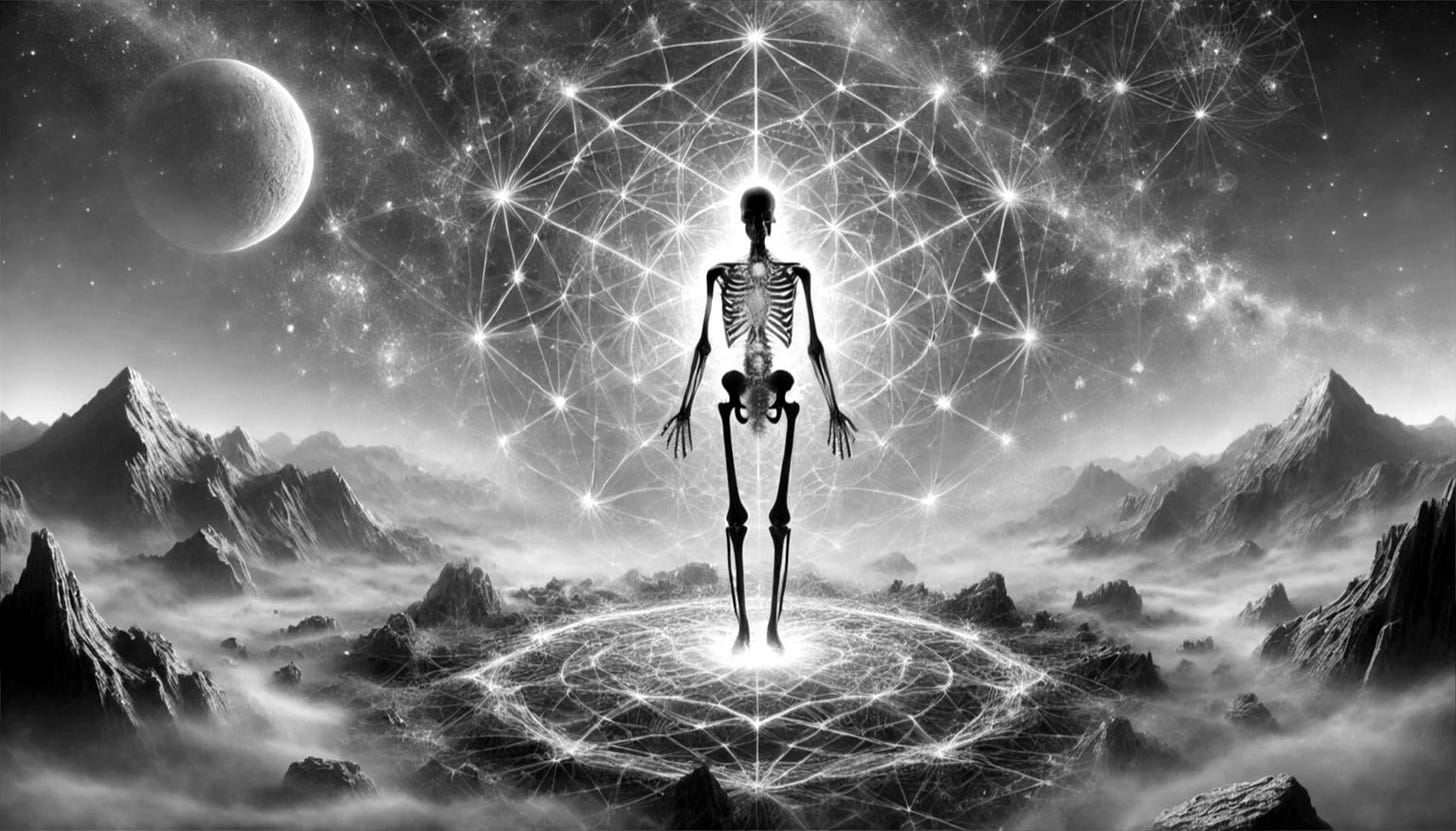
Quantum Mechanics and ITC: Bridging Realms Through Science
Quantum mechanics provides a framework for understanding ITC by demonstrating the deep interconnectedness of particles and dimensions, where information transfer transcends physical boundaries. For example, quantum entanglement—where two particles remain linked regardless of distance—suggests that information can travel instantaneously. This phenomenon aligns with ITC’s premise, suggesting entities can interact across realms, transcending physical boundaries.
How Quantum Nonlocality Enables Cross-Realm Communication
Theory: ITC leverages quantum entanglement and parallel dimensions to facilitate communication.
Process: Entities influence probabilistic states within quantum systems, producing EVPs or other anomalies.
Support:
• Quantum mechanics reveals the interconnectedness of particles across distances.
• The many-worlds interpretation suggests multiple dimensions where entities might reside.
Quantum nonlocality is like wireless earbuds: no matter how far apart they are, they remain perfectly synchronized. ITC might work similarly, with entities and devices sharing an invisible link that allows them to communicate instantly across vast distances.
Parallel dimensions can be likened to radio stations broadcasting simultaneously. ITC devices act as calibrators, helping us “dial in” to a station outside our normal frequency range.
If quantum mechanics reveals the interconnectedness of particles, information field theories reveal what they might be connected to—a universal repository of knowledge and memory, waiting to be accessed.
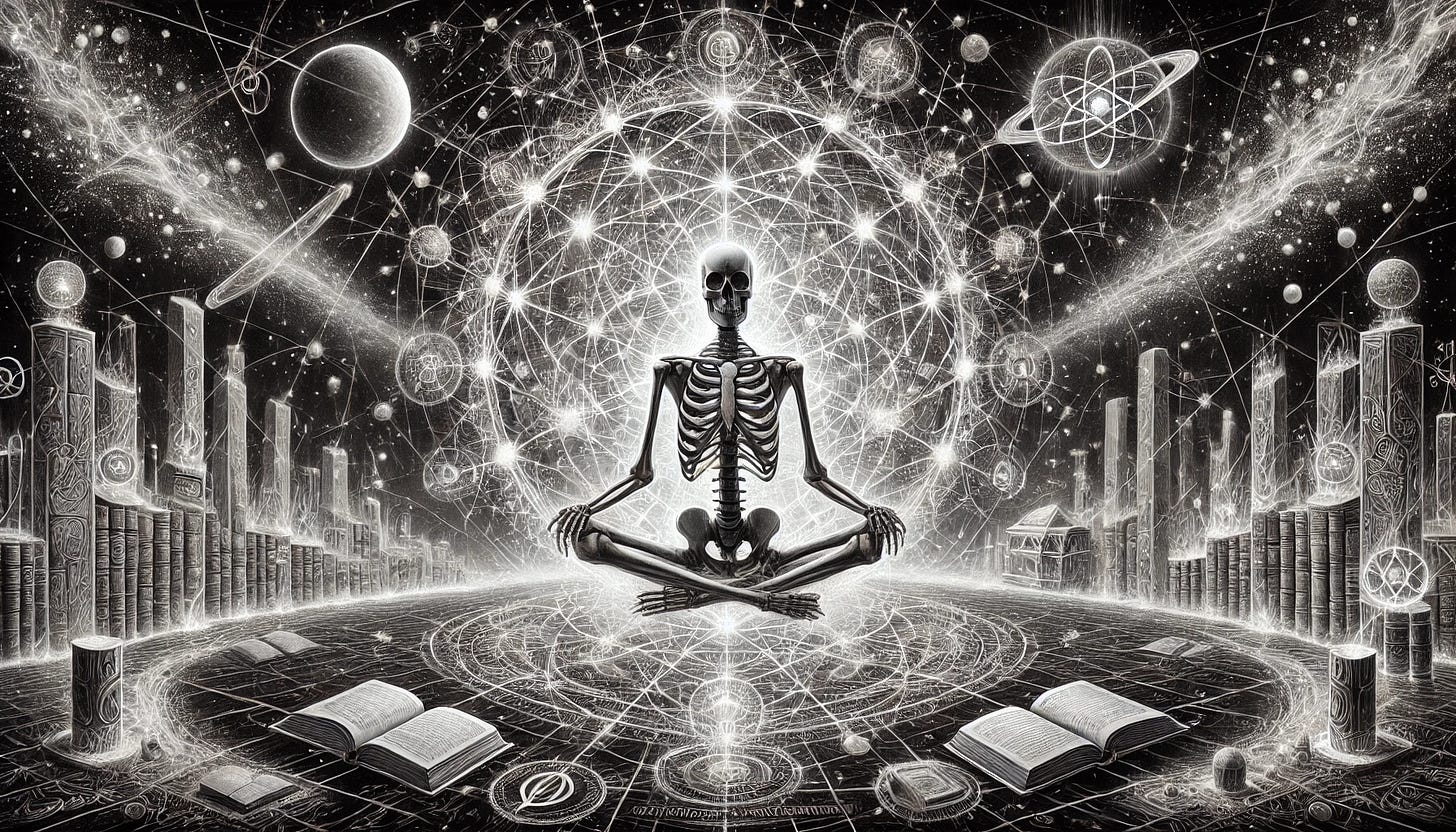
The Akashic Field in ITC: Unlocking a Universal Repository of Knowledge
The Akashic Field, often described as a universal repository of all events, thoughts, and knowledge, offers an intriguing framework for ITC communication. ITC devices may serve as tools to decode and access this vast archive, allowing relevant information to manifest in sessions.
• Ervin Laszlo’s2 Akashic Field Hypothesis: Laszlo integrates physics and metaphysics, proposing that the Akashic field is an interconnected “information field” storing the history of the universe. ITC communications, with their coherent and contextually relevant messages, appear to tap into this collective data source.
• ITC Devices as Librarians: Imagine the Akashic Field as a cosmic library where ITC devices function as librarians retrieving specific records. This concept aligns with the consistent, meaningful messages often recorded in ITC experiments, suggesting access to a universal database.
By framing the Akashic Field as a theoretical foundation for ITC, researchers gain a deeper understanding of how unseen realms and information systems may overlap, offering both practical insights and philosophical wonder.
Imagine the Akashic field as a cosmic archive containing every thought, action, and event in history. ITC tools act like librarians, retrieving specific ‘records’ of information relevant to the session.
Mark Macy’s Spirit Groups: Pioneering Spirit Communication
Mark Macy’s groundbreaking ITC research explores how advanced entities—organized into cooperative “Spirit Groups”—use technology to bridge dimensions and deliver profound insights into the afterlife. While inspired by early ITC attempts such as Spiricom, Macy’s research focused on Timestream, a collective of spirit-world communicators who established contact through electronic devices, including radio, television, and computers. His experiments documented coherent, contextually relevant messages, aligning with theories of a universal information field and interdimensional communication.
Macy’s work emphasizes the importance of intention and vibrational harmony in fostering successful ITC contact, underscoring that ITC is not merely a technological tool but also a profound spiritual practice. His findings further substantiate the Akashic field hypothesis, suggesting that ITC can serve as a conduit to access collective knowledge and higher consciousness. By integrating ethical responsibility and mindfulness into ITC methodologies, Macy’s research reveals the transformative potential of spirit communication to deepen our understanding of existence and consciousness.
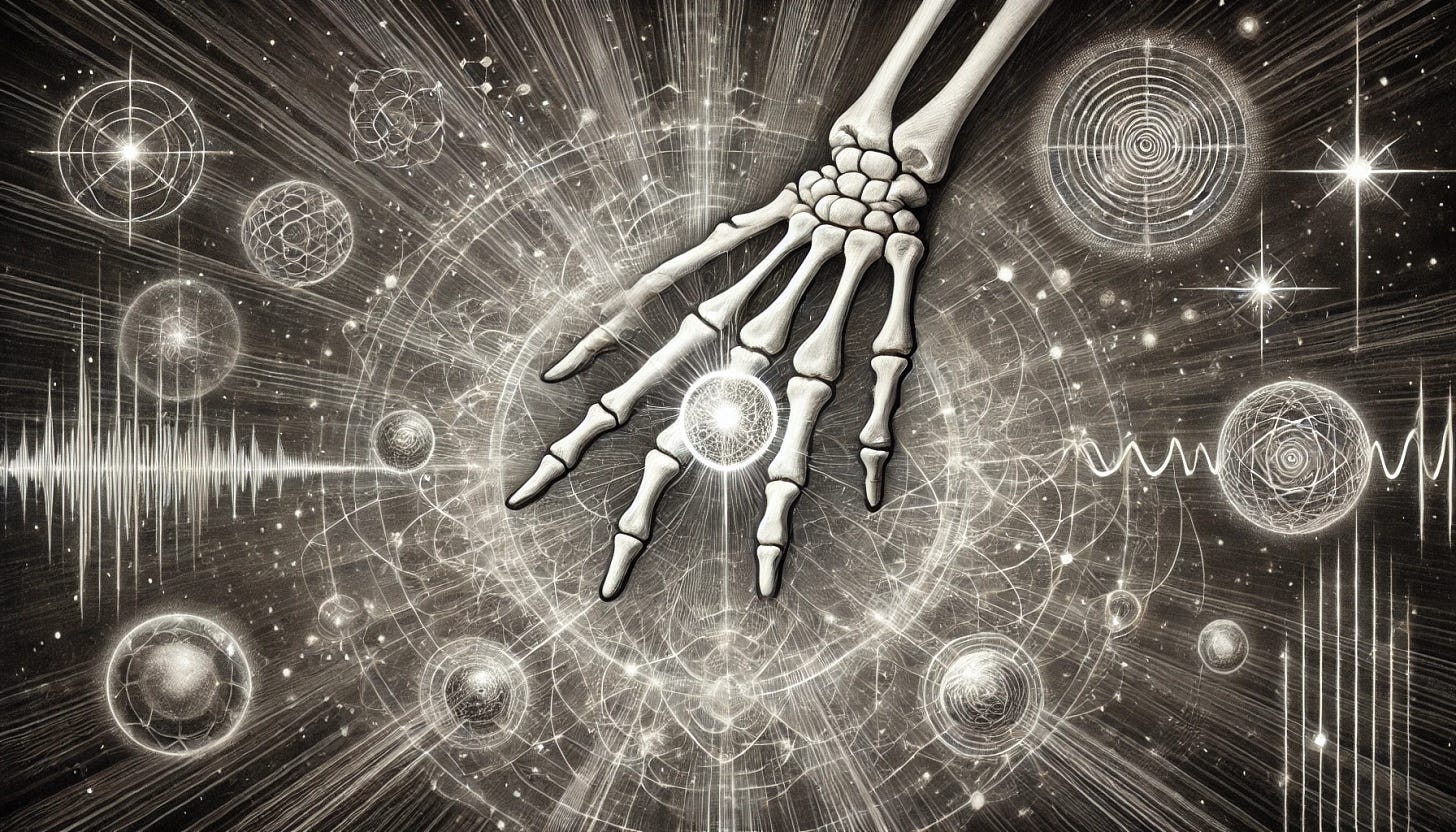
Intent and Psychokinesis: Shaping ITC Results
Theory: ITC results from the combined intent of investigators and entities. This process hinges on the concept of mind-matter interaction, where focused human consciousness influences subtle energetic systems and communication outcomes.
Process: During ITC sessions, focused intention by investigators generates a mind-matter interaction, creating a psychokinetic effect that subtly influences devices, environmental conditions, and even the clarity of entity responses. This collaborative effort positions investigators as active participants in shaping the session’s outcome, amplifying the connection between the physical and non-physical realms.
Support:
Research from the Princeton Engineering Anomalies Research (PEAR) Lab demonstrates the measurable impact of human intention on physical systems, including random number generators, supporting the theory of mind-matter interaction.
The results suggest that human consciousness actively participates in ITC sessions, bridging the gap between physical systems and non-physical entities.
Anecdotal reports from ITC practitioners highlight how setting a clear intention enhances the coherence and relevance of responses, reinforcing the interplay between mind, matter, and communication with other realms.
By integrating mind-matter interaction into ITC methodology, this framework emphasizes the essential role of human consciousness in shaping meaningful communication with non-physical entities.
Esoteric Foundations of ITC: Hermetic Principles and Rituals

How ITC Aligns with the Laws of Vibration and Correspondence
Theory: ITC aligns with Hermetic laws, such as the principles of vibration and correspondence, which state that the universe operates through interconnected energetic and vibrational patterns.
Process: Devices may act as instruments to access subtle planes of reality where these principles manifest.
Support:
The Hermetic principle As above, so below suggests a mirroring between physical and spiritual realms, offering a framework for ITC connections.
Occult practices often emphasize tools (e.g., mirrors, pendulums) as mediums for communication, much like ITC devices.
The Role of Intentional Rituals in Strengthening ITC Connections
Theory: The structured environments and symbolic intent often used in occult practices could enhance ITC sessions by focusing energy and intent.
Process: Ritual acts, such as protective symbols or focused meditation, may stabilize the communication process and protect against interference.
Support:
Historical accounts of mediumship and ritual communication share similarities with modern ITC, including consistent patterns in responses.
Occult traditions suggest that tools used with clear intent amplify their effectiveness, a concept mirrored in ITC methodologies.
While some may dismiss Hermetic principles and ritualistic practices as pseudoscience, they play a crucial role in ITC’s holistic approach. These symbolic frameworks are not just spiritual traditions—they align with concepts in physics and metaphysics, offering a unique lens for understanding how energy and intention intersect. Addressing these principles with thoughtful inquiry highlights their potential to bridge ancient wisdom with modern technology, rather than dismissing them outright.
The occult provides a symbolic and ritualistic framework for ITC, but how do these practices align with the historical and philosophical underpinnings of Spiritualism?
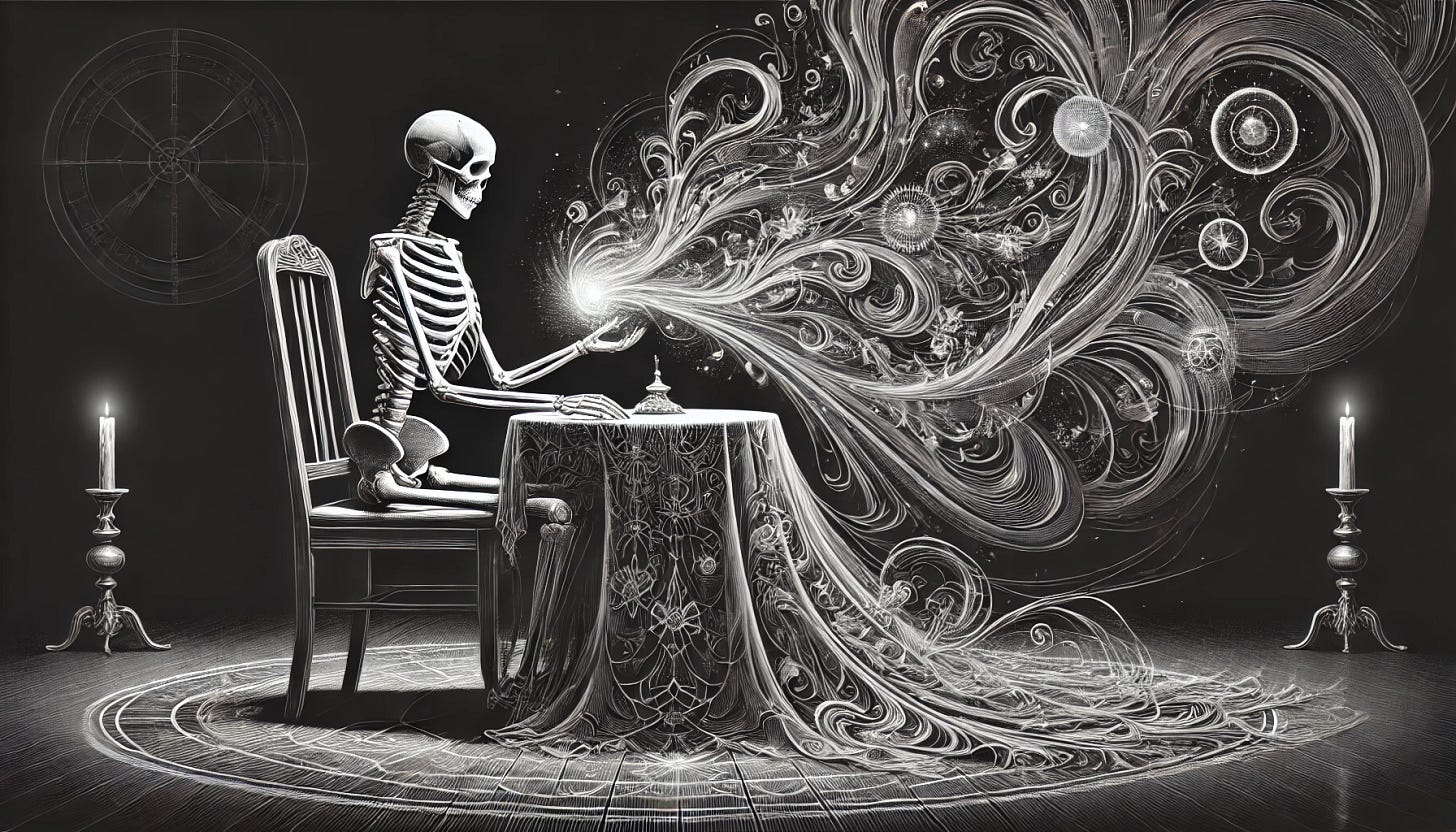
ITC and Spiritualism: A Modern Pathway to the Afterlife
Spiritualism, with its rich history of exploring communication with spirits, shares profound parallels with ITC. Both aim to connect with unseen entities to understand the nature of the afterlife and gain insight from higher realms. ITC builds on Spiritualism’s principles by introducing a technological pathway for these communications, transforming the traditional role of human mediums into a structured, interference-free process.
The Role of Mediums and ITC Devices as Conduits
In Spiritualism, mediums act as bridges between the physical and spiritual realms. ITC devices, by contrast, can be viewed as “technological mediums,” facilitating communication through electromagnetic fields, sound waves, or vibrations. Both methods rely on intermediaries to bridge dimensions.
Vibrational Planes and the Evolution of the Soul
Spiritualism teaches that the soul evolves after death, existing on higher vibrational planes. This concept aligns with ITC’s focus on specific frequencies to connect with entities, including those potentially beyond human comprehension. By modulating these frequencies, ITC tools access vibrational levels Spiritualists describe as gateways to higher consciousness.
Scientific Inquiry and the Legacy of Spiritualist Pioneers
Since the 19th century, Spiritualism has sought to unite spiritual beliefs with empirical methods. Researchers like Sir William Crookes3 and Frederick Myers4 pioneered systematic studies of spirit phenomena, a legacy continued by modern ITC researchers using advanced technologies to validate communication.
Tuning into Frequencies: The Intersection of Spiritualism and ITC
Spiritualism emphasizes that the afterlife exists across multiple vibrational levels. ITC mirrors this idea by using frequency modulation to create pathways for communication. Devices like PRISM take this concept further, offering precise, interference-free channels to explore these realms.
While Spiritualism laid the philosophical foundation for connecting with unseen dimensions, ITC represents its technological evolution. By combining metaphysical principles with cutting-edge tools, ITC transcends traditional practices, providing new opportunities to explore the mysteries of existence. But just like Spiritualism of old, ITC comes with its own baggage. Despite advances, ITC continues to face resistance from skeptics who demand replicable results and question its scientific merit. Addressing these concerns requires not only technological breakthroughs like PRISM but also a shift in how we define and evaluate evidence in consciousness studies.

Overcoming Skepticism: Science, Philosophy, and ITC’s Future
How ITC Messages Surpass Patterns in Random Noise
Critics often dismiss ITC as the result of pareidolia—the human tendency to perceive patterns in randomness—or confirmation bias. While these concerns warrant attention, they fail to explain the coherence and specificity of many ITC messages. For example, cases like the Scole Experiment produced historically accurate details that defy the randomness explanation.
Addressing Replication Issues in Paranormal Communication
Skeptics say ITC’s inconsistent, unpredictable results challenge its acceptance in scientific circles.
Counterpoint: The subjective nature of consciousness may resist strict replication. Technologies like PRISM aim to address replicability by creating interference-free environments for ITC communications.
Overcoming Materialist Critiques with Quantum Theory
Skeptics claim ITC can be explained through known physical laws, such as radio interference, environmental noise, or psychological bias, dismissing the need for metaphysical interpretations.
Counterpoint: Materialism itself is being challenged by quantum theories like nonlocality and observer effects, which suggest that consciousness may actively shape reality. ITC could represent an example of consciousness interacting with physical systems in ways that defy traditional paradigms.
Historical Support: Researchers like Sir William Crookes and Frederick Myers systematically studied ITC-like phenomena under controlled conditions, revealing evidence that remains unexplained by conventional science. Dismissing ITC outright risks overlooking this significant body of evidence.
Metaphysical Skepticism: The Trickster Archetype and Deception in ITC
Metaphysical skepticism goes beyond materialist critiques to question the source and intent of ITC communications. Could these messages be deceptive—or even malevolent? The Trickster archetype, a universal figure in mythology and folklore, provides a useful framework for understanding the erratic and unreliable nature of some ITC phenomena.
The Trickster archetype can be thought of as a joker in a card game. It thrives on disruption and unpredictability, making us question the rules of the game itself. In ITC, this could mean receiving fragmented or contradictory messages, forcing researchers to dig deeper into their methods and assumptions.
The Trickster Archetype: Chaos and Insight in ITC Communications

The Trickster, found in myths across cultures (e.g., Pan, Loki, Hermes), embodies paradox, deception, and disruption. As George P. Hansen5 explores in The Trickster and the Paranormal, this archetype thrives in liminal spaces—transitional zones between the material and immaterial, rational and irrational. ITC, operating at the intersection of science, spirituality, and technology, naturally invites the Trickster’s influence.
Unpredictability and Chaos: Hansen highlights the Trickster’s role in fostering uncertainty, encouraging researchers to refine their methods amidst ambiguity.
Catalyst for Growth: The Trickster’s disruptive nature pushes researchers to refine their methods, embrace ambiguity, and explore new paradigms.
Evil or Deceptive Intent
Many spiritual traditions caution against uncritical engagement with unseen entities, suggesting some may present as benevolent but harbor harmful intentions.
Historical and Religious Warnings
The Bible warns of “spirits of deception” appearing as angels of light.
Medieval demonological texts describe entities that thrive on chaos and confusion, aligning with fragmented ITC communications.
Folklore portrays supernatural interactions as double-edged, offering insight but exposing individuals to risks.
Mitigation Strategies: Protective measures such as clear intentions, ritual boundaries, and emotional stability can reduce risks, ensuring ITC practices remain disciplined and focused.
Carl Jung: Archetypes and Synchronicity
Swiss psychiatrist Carl Jung6 expanded the Trickster’s meaning through his work on archetypes and the collective unconscious. He saw the Trickster as a paradoxical force that disrupts order to reveal hidden truths, often manifesting in symbolic or fragmented ways.
Archetypal Force: In ITC, Trickster-like communications challenge researchers to interpret deeper meanings behind apparent randomness.
Synchronicity: Jung’s theory of meaningful coincidences aligns with ITC, where contextually relevant messages emerge, suggesting an interconnected reality where psyche and matter converge.
Jacques Vallée: Bridging Realities
Jacques Vallée7, a computer scientist and ufologist, explored the Trickster in unexplained phenomena such as UFO encounters and folklore, drawing parallels with ITC.
Folklore and Continuity: Vallée observed that modern paranormal events often mirror ancient myths, suggesting a continuity of Trickster-like behaviors. ITC may represent a technological extension of these interactions, with the Trickster adapting to new mediums.
A Challenge to Perception: Vallée argued that the Trickster disrupts conventional understanding to provoke spiritual and intellectual growth. In ITC, this can manifest as perplexing yet meaningful responses that push researchers to think beyond materialist paradigms.
Control System Hypothesis: Vallée proposed that a “control system” manipulates human consciousness to promote growth, with the Trickster playing a central role. This aligns with ITC’s unpredictable nature, encouraging dynamic engagement with the unknown.
A Unified Perspective on the Trickster
The combined insights of Hansen, Jung, and Vallée illustrate the Trickster’s multifaceted role in ITC:
Hansen: Highlights the liminal spaces that invite the Trickster’s presence.
Jung: Frames the Trickster as a transformational force within the collective unconscious.
Vallée: Connects the Trickster to historical, cultural, and metaphysical dimensions, situating ITC within a continuum of human experiences.
Navigating the Trickster’s Challenges
While the Trickster can introduce chaos and deception, it also serves as an invitation to explore the unknown with discipline and curiosity. Researchers can navigate these challenges by:
Setting clear intentions and boundaries.
Maintaining emotional and psychological stability.
Recognizing the symbolic and archetypal dimensions of their findings.
As ITC continues to evolve, integrating technological innovation with foundational metaphysical theories becomes critical. Enter PRISM—a groundbreaking advancement that not only addresses historical skepticism but also redefines the framework of ITC communication.
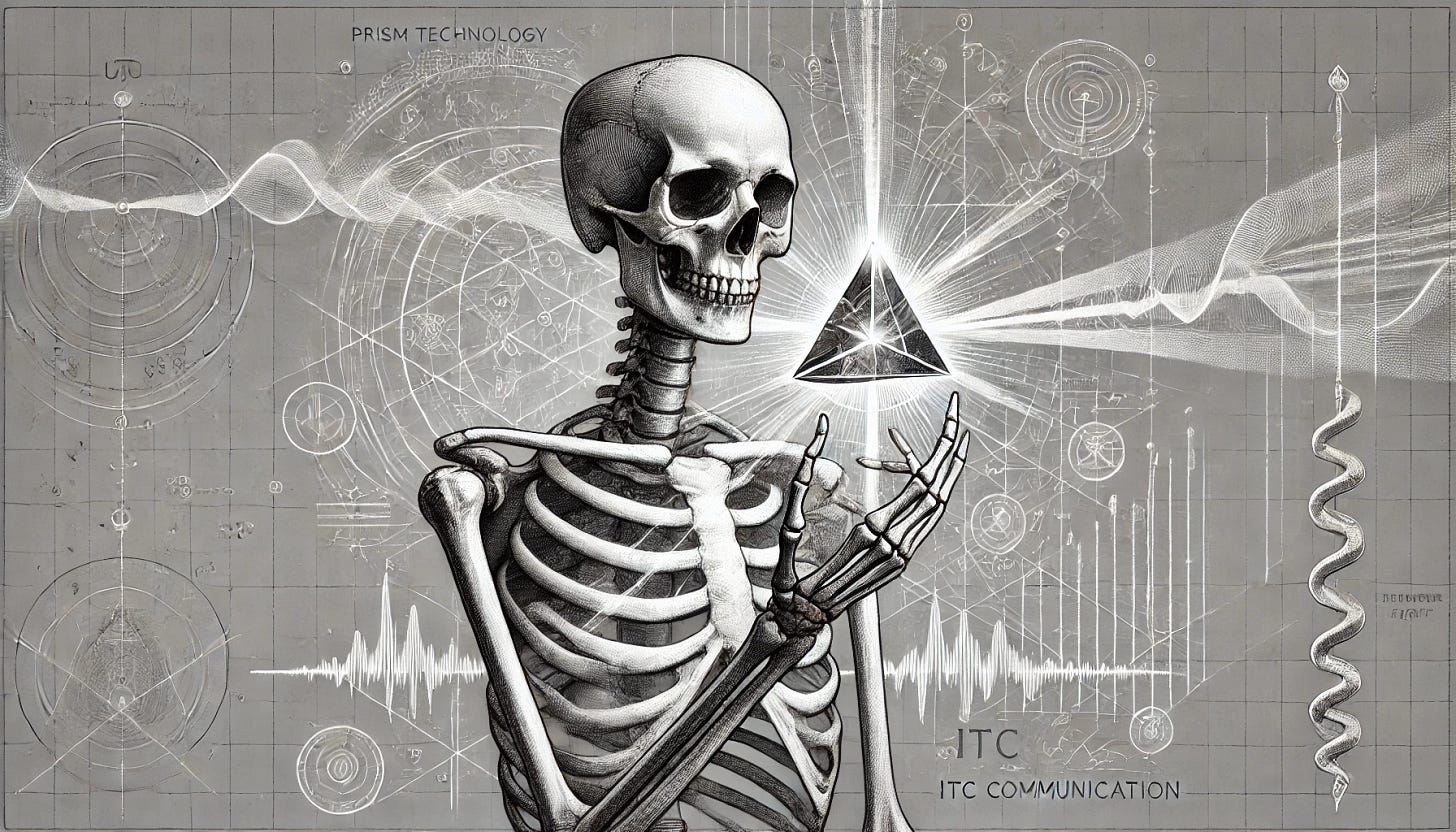
PRISM Technology: Revolutionizing ITC Communication
A patent-pending method for ITC, known as PRISM, has been developed by audio scientist Joshua Sean, PhD. of Zero-G ITC. This innovative approach addresses many criticisms raised by skeptics and represents a significant advancement in the field. Fortunately, he has allowed me to pilot this endeavor. PRISM has been transformative for me, not only in my ITC research but also in reshaping my understanding of the potential nature of reality. Below is a condensed list of key features that make PRISM an extraordinary leap forward for ITC.
Closed-Circuit Design: By eliminating external interference such as radio waves, internet signals, or generative AI. PRISM ensures that communications are free from contamination.
Frequency Modulation: PRISM uses specific light frequencies transposed into sound, creating a controlled environment where entities can communicate.
Results: Early experiments with PRISM show a marked improvement in response relevance and timing compared to traditional ITC methods, offering a level of credibility unmatched by other tools.
As PRISM evolves, its potential to enhance ITC research and address skepticism grows. By bridging technological innovation with metaphysical inquiry, it provides an invaluable tool for exploring the boundaries of communication with unseen realms.

ITC: A Unified Perspective
ITC unites diverse frameworks, dissolving barriers between scientific, philosophical, and spiritual approaches to understanding the unknown. It invites us to see these perspectives as complementary rather than competing, enriching our understanding and reinforcing the idea that no single approach holds all the answers.
Consciousness as the Framework: ITC builds on the concept that consciousness forms the foundation of reality, offering a bridge for meaningful communication across dimensions.
Vibrations and Energy as the Medium: Resonance, frequency, and quantum nonlocality provide pathways that connect the physical and metaphysical realms.
Technological Innovation as the Translator: Advancements in tools and techniques that isolate and amplify meaningful responses have transformed ITC into a more rigorous and expansive field of inquiry.
Thomas Campbell's LCS model underscores how ITC offers not only practical methods for communication but also a profound framework for understanding the mechanics of consciousness and its interaction with unseen dimensions. While tools like PRISM lend tangible weight to these theories, ITC’s true power lies in its capacity to be many things to many people. Each of us brings our own beliefs, experiences, and questions to the process, shaping how we interpret the messages we receive.
By uniting the scientific, philosophical, and spiritual aspects of communication, ITC encourages us to approach the unknown with curiosity rather than certainty. This adaptability allows researchers to blend personal exploration with collective discovery, ensuring that the journey remains as boundless as the dimensions it seeks to explore.
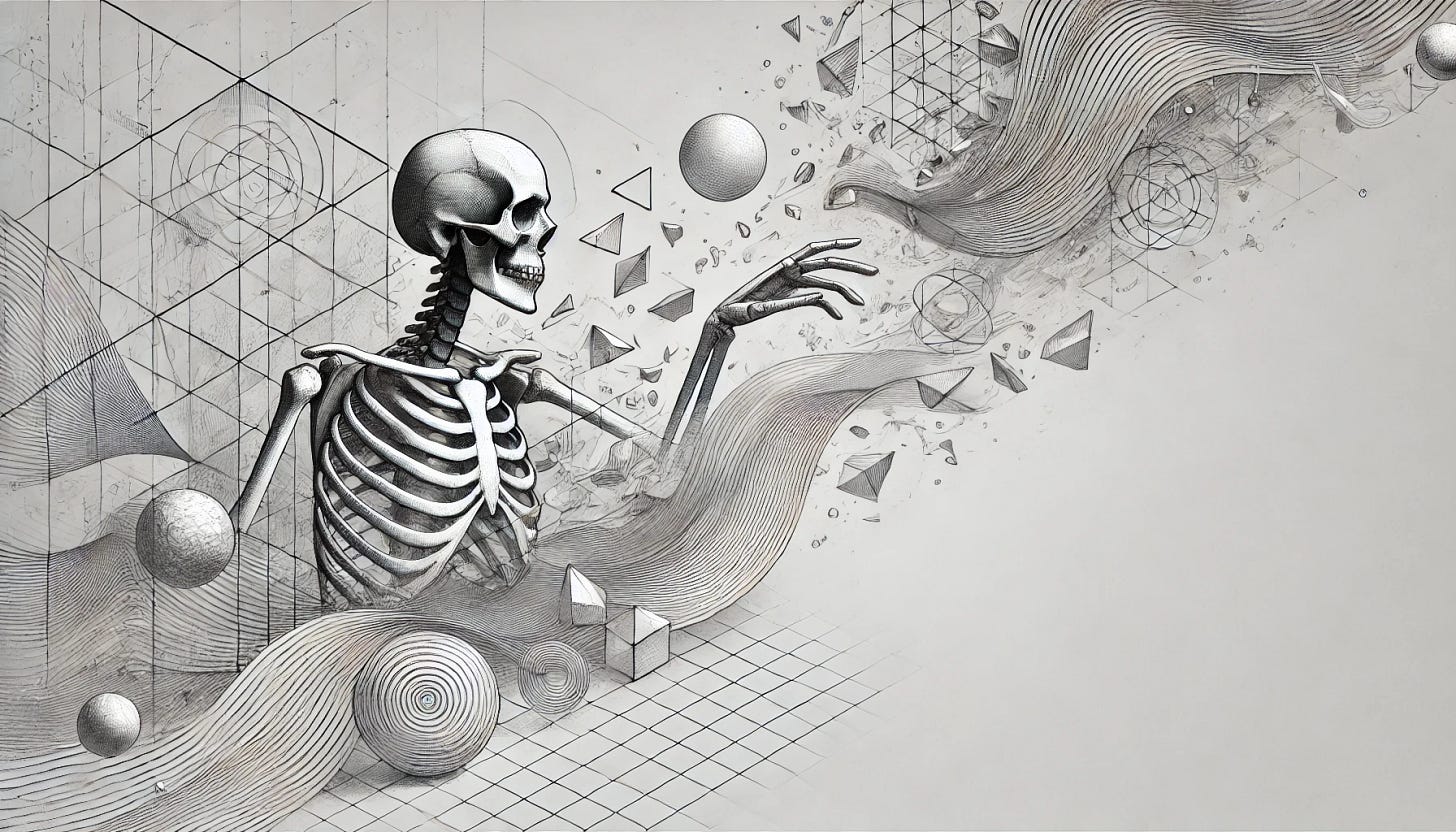
Assembling the Skeleton of a New Reality
The bones of ITC represent more than a framework—they are the scaffolding for a new way of perceiving existence. By intertwining consciousness, science, and technology, ITC challenges us to venture beyond the edges of what we think is possible, offering a profound glimpse into the interconnected nature of reality.
ITC is not merely a means of reaching the others; it is a journey of self-discovery. Each message we receive invites us to question subjectivity, expand possibilities, and redefine the boundaries of what it means to exist. Its versatility ensures it remains inclusive of multiple perspectives, regardless of the lens you view ITC through.
What sets ITC apart is its collaborative nature—no single discipline or theory can contain its full potential. Every insight contributes to a growing framework that is both universal and deeply personal. As we refine our tools, challenge our assumptions, and perhaps break a few bones along the way, we uncover that ITC’s revelations are not just about understanding the unknown but about illuminating the intricate connections that define our reality.
The journey ahead is limitless. ITC is more than a bridge to unseen dimensions—it is the blueprint for understanding our place in a universe far more interconnected and extraordinary than we ever imagined. By embracing its evolving nature, we open ourselves to a future defined by discovery, unity, and the boundless potential of consciousness.
— M. D. Jackson
Seven Reflections on the Unseen
These questions invite you to dive into Instrumental TransCommunication and your own beliefs about existence and the invisible realms beyond. By pondering the interplay of technology, consciousness, and mystery, you may uncover new insights into what connects us to the unknown.
1. How might ITC reveal hidden aspects of reality that extend beyond the boundaries of human perception?
2. If consciousness is the foundation of all existence, what role do intention and perception play in shaping ITC communication?
3. Could ITC provide more than just messages from unseen entities—perhaps a means to understand the fabric of existence itself?
4. How can researchers distinguish between authentic communication and phenomena shaped by human expectation or the Trickster archetype?
5. What does ITC’s exploration of other dimensions suggest about the interconnectedness of all things, both seen and unseen?
6. Could ITC demonstrate that the boundaries between science, spirituality, and metaphysics are more fluid than previously imagined?
7. What ethical responsibilities do researchers have when engaging with unseen entities, and how do these responsibilities shape ITC methodologies?
Inspired to explore further? Join us at ObscuraVox.com for immersive ITC sessions, cutting-edge theories, and a community passionate about the unseen. Share your reflections, connect with others, and deepen your journey into the mysteries of consciousness and technology.
Sources:
Books
• Campbell, T. (2003). My Big TOE: A Trilogy Unifying Philosophy, Physics, and Metaphysics. Lightning Strike Books. ISBN: 978-0972509466.
• Crookes, W. (1874). Researches in the Phenomena of Spiritualism. J. Burns.
• Hansen, G. P. (2001). The Trickster and the Paranormal. Xlibris Corporation. ISBN: 978-1401000820.
• Jung, C. G. (1960). Synchronicity: An Acausal Connecting Principle. Princeton University Press. ISBN: 978-0691150505.
• Laszlo, E. (2007). Science and the Akashic Field: An Integral Theory of Everything. Inner Traditions. ISBN: 978-1594771811.
• Myers, F. W. H. (1903). Human Personality and Its Survival of Bodily Death. Longmans, Green & Co. ISBN: 978-0486438184 (2005 reprint).
• Vallée, J. (1969). Passport to Magonia: From Folklore to Flying Saucers. Henry Regnery Company. ISBN: 978-0987422484 (2014 reprint).
Journal Articles
• Barušs, I. (2007). An experimental test of instrumental transcommunication. Journal of Scientific Exploration, 21(1), 89–98. https://journalofscientificexploration.org/index.php/jse/article/view/175/0
• Jahn, R. G., & Dunne, B. J. (2006). The PEAR proposition. Journal of Scientific Exploration, 20(3), 371–391. https://journalofscientificexploration.org/index.php/jse/article/view/95/0
• Keen, M., Ellison, A., & Fontana, D. (1999). The Scole report. Proceedings of the Society for Psychical Research, 58(220), 147–455.
Web Articles
• Jackson, M. D. (2024). The world premiere of PRISM. Obscura Vox. https://www.obscuravox.com/p/the-world-premiere-of-prism
• Sean, J. (n.d.). Zero-G ITC. https://www.instagram.com/zerogitc/
Biographical Notes:
Thomas Campbell
Thomas Campbell is a physicist, consciousness researcher, and author of the influential trilogy My Big TOE (Theory of Everything). With a career that began in applied physics, Campbell worked extensively in the fields of large-system simulations and missile defense systems for NASA and other organizations. However, his passion for understanding the nature of reality and consciousness led him to groundbreaking research that bridges physics, metaphysics, and spirituality.
In the 1970s, Campbell began collaborating with Robert A. Monroe at the Monroe Institute, a world-renowned research center exploring altered states of consciousness, frequency modulation, and out-of-body experiences (OBEs). Monroe, a pioneer in the field of consciousness studies, developed Hemi-Sync® technology, a method of synchronizing the brain’s hemispheres to induce altered states of awareness. Campbell played a vital role in scientifically studying and validating the effects of these techniques.
Through his work with the Monroe Institute, Campbell not only gained firsthand experience with OBEs but also deepened his understanding of how humans can interact with non-physical dimensions and unseen entities. This collaboration provided a foundation for his larger theory of reality, which posits that consciousness is the fundamental substrate of existence. He describes reality as a digital simulation governed by a Larger Consciousness System (LCS), in which each of us is an individuated unit of consciousness engaged in continuous interaction, learning, and evolution.
A cornerstone of Campbell’s work is his explanation of how we encounter interdimensional or unseen entities and exchange information with them. According to his model, these entities are part of the LCS and exist within different data streams or frequency ranges. Human consciousness can “tune in” to these data streams by shifting focus, much like tuning a radio to access different stations. ITC, in Campbell’s view, operates on a similar principle, serving as a tool that allows entities to exchange meaningful information with individuals through technology.
Campbell’s theories go further to suggest that these interactions are not random but purposeful, contributing to the evolution of consciousness itself. When we engage with these non-physical entities—whether through ITC, OBEs, or meditation—we participate in a feedback loop that enhances our awareness and understanding of reality. At the same time, these interactions can serve the growth of the LCS, which evolves through the reduction of entropy (disorder) and the increase of meaningful, cooperative exchanges of information.
In Campbell’s framework, the evolution of individual consciousness is inseparable from the evolution of the larger system. Every encounter with unseen entities, every exchange of information, and every shift in perspective adds to the collective growth of reality. These insights align closely with the principles of ITC, where communication is not merely an exchange of words or messages but a profound opportunity to explore the nature of existence, uncover truths about ourselves, and deepen our connection to the larger reality we inhabit.
Today, Campbell’s work continues to inspire researchers and practitioners seeking to understand the mechanisms behind consciousness and its role in shaping the universe. His integration of scientific rigor with experiential insights provides a compelling framework for exploring phenomena like ITC, psychic abilities, and spiritual development, while his emphasis on purpose and growth offers a hopeful vision of how humans can expand their awareness and actively participate in the evolution of reality itself. Find out more at
https://www.my-big-toe.com/
Ervin Laszlo
Ervin Laszlo (b. 1932) is a Hungarian philosopher of science, systems theorist, and advocate of the Akashic field hypothesis. In his book Science and the Akashic Field: An Integral Theory of Everything, Laszlo proposes that the universe operates as an interconnected “information field” (the Akashic field) that stores and transmits all knowledge and events. This theory bridges quantum physics, cosmology, and metaphysics, suggesting a unified field where consciousness and material reality intersect. ITC’s contextually relevant messages often align with Laszlo’s hypothesis, supporting the idea of a universal repository of information accessible through technology.
Sir William Crookes
Sir William Crookes (1832–1919) was a British chemist and physicist whose groundbreaking work included the discovery of thallium and the study of cathode rays, laying the foundation for modern atomic theory. Beyond his scientific achievements, Crookes conducted systematic investigations into spiritualist phenomena. Working with renowned mediums like Florence Cook and Daniel Dunglas Home, he documented materializations, levitations, and unexplained physical interactions under controlled conditions. Crookes’s detailed experiments, often met with skepticism from his peers, remain a pivotal contribution to the scientific study of paranormal phenomena and provide a historical foundation for the methodologies of ITC research.
Frederick W. H. Myers
Frederick W. H. Myers (1843–1901) was a British poet, philosopher, and psychical researcher who co-founded the Society for Psychical Research (SPR) in 1882. Dedicated to bridging the gap between science and spirituality, Myers explored mediumship, telepathy, and apparitions. He introduced the concept of the “subliminal self,” suggesting that consciousness extends beyond the physical body and interacts with unseen forces. His seminal work, Human Personality and Its Survival of Bodily Death, remains a cornerstone of parapsychology and has profoundly influenced ITC researchers. Myers’s systematic approach to investigating the survival of consciousness laid the groundwork for contemporary efforts to use technology in spirit communication.
George P. Hansen
George P. Hansen is a parapsychologist and author of The Trickster and the Paranormal. Hansen explores the archetype of the Trickster—embodied in mythological figures like Loki, Hermes, and Pan—and its connection to paranormal phenomena. He posits that paranormal events often occur in “liminal spaces,” where conventional structures and boundaries blur. Hansen’s work provides a framework for understanding the chaotic, unreliable, and sometimes deceptive nature of ITC communications, emphasizing the importance of disciplined inquiry and interpretation in paranormal research.
Carl Gustav Jung
Carl Gustav Jung (1875–1961) was a Swiss psychiatrist and psychoanalyst who founded analytical psychology. He is best known for his groundbreaking theories on the collective unconscious, archetypes, and synchronicity, which have had profound impacts on psychology, philosophy, and the study of the paranormal. Jung believed that the collective unconscious is a shared reservoir of experiences and symbolic motifs that transcend individual consciousness, manifesting through universal archetypes such as the Hero, the Shadow, and the Trickster.
Jung’s concept of synchronicity—meaningful coincidences that defy cause-and-effect explanations—offers a compelling framework for ITC. These moments of synchronicity, often reported during ITC sessions, suggest an underlying interconnectedness between psyche and matter. Jung’s work highlights the symbolic nature of ITC communications, encouraging researchers to consider how archetypal forces like the Trickster influence unpredictable or enigmatic messages. His focus on inner exploration and the symbolic dimension of experience remains a vital lens for interpreting ITC phenomena.
Jacques Vallée
Jacques Vallée (b. 1939) is a French-American computer scientist, venture capitalist, ufologist, and author whose work bridges science, folklore, and the paranormal. With a background in astrophysics and artificial intelligence, Vallée initially contributed to the development of ARPANET, a precursor to the modern internet. However, he is best known for his influential research on UFO phenomena and their parallels with folklore and mythology, as explored in books like Passport to Magonia and The Invisible College.
Vallée introduced the idea that paranormal and UFO phenomena often reflect Trickster-like behavior, blending reality and imagination to challenge human understanding. His Control System Hypothesis posits that these phenomena may be part of a broader mechanism designed to provoke intellectual and spiritual growth by disrupting conventional worldviews. This perspective aligns with ITC, where the Trickster archetype can blur the boundaries between material and immaterial realities. Vallée’s work emphasizes the continuity of unexplained phenomena across cultures and epochs, suggesting that ITC may represent a technological extension of ancient interactions with the unknown.


